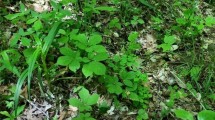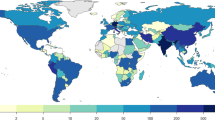Abstract
Asian ginseng played an integral role in traditional Chinese medicine for millennia, but overexploitation of the plant, coupled with habitat loss, contributed to steep declines in natural populations throughout China. The discovery of the closely related medicinal herb, American ginseng, in Canada in the early 1700s ignited three centuries of trade between North America and China. Profits made from the export of American ginseng to China facilitated western expansion in the United States, and the fortunes of some early Americans were built on the American ginseng trade. American ginseng has been harvested continuously in North America following its initial discovery, punctuated by regional spurts of intense harvest in response to economic needs of rural residents. The ongoing extraction of American ginseng from deciduous forests throughout its range have resulted in modern populations that contain fewer individuals and individuals of smaller stature relative to historic populations, yet thousands of these remnant populations remain. In fact, concerns about overharvest of American ginseng led to its placement on Appendix II of the Convention on the International Trade in Endangered Species of Wild Fauna and Flora (CITES) in 1975. Overexploitation, however, is not the only threat to wild populations of American ginseng. Climate change and browse by overabundant white-tailed deer also negatively affect American ginseng and pose a threat to the future viability of populations. Conservation efforts are needed to ensure that populations of wild American ginseng persist. Population stewardship is a low-labor conservation strategy where individuals promote the growth of wild ginseng populations by strategically planting seeds and removing the aboveground portion of large plants just prior to the onset of harvest season to prevent potential harvesters from locating the adult plants. Another conservation strategy, conservation through cultivation, involves shifting harvest pressure from wild American ginseng to cultivated ginseng. Wild-simulated cultivation is a low-labor technique where seeds are planted into desirable habitat and are left to grow with little intervention until the roots are ready for harvest years later. Wild-simulated cultivation produces roots that are virtually indistinguishable from true wild roots, which makes this type of cultivation a desirable option for the conservation through cultivation approach. Additional cultivation techniques include woods-cultivation, which is ginseng grown in prepared beds under natural forest canopies, and artificial shade cultivation, which is the most labor-intensive cultivation technique and requires large initial investments in shade structures and site preparation. The last two cultivation techniques can produce large roots and abundant seeds in a short period of time. However, the roots lack morphological features desired in traditional Chinese medicine, and are less valuable than both wild-simulated and true wild roots. The abundance and size of wild American ginseng populations are decreasing range-wide, and this negative trajectory is certain to continue unless efforts are made to both improve the management of wild populations and to increase conservation efforts.
Access this chapter
Tax calculation will be finalised at checkout
Purchases are for personal use only
Similar content being viewed by others
References
Anderson RC (1994) Height of white-flowered trillium (Trillium grandiflorum) as an index of deer browse intensity. Ecol Appl 4:104–109
Augustine DJ, Frelich LE (1998) Effects of white-tailed deer on populations of an understory forb in fragmented deciduous forests. Conserv Biol 12:995–1004
Bailey B (1999) Social and economic impacts of wild harvested products. Ph.D. dissertation, Morgantown, West Virginia
Burkhart EP (2011) Conservation through cultivation: Economic, sociopolitical and ecological considerations regarding the adoption of ginseng forest farming in Pennsylvania. Doctor of Philosophy, The Pennsylvania State University, State College
Burkhart EP, Jacobson MG (2009) Transitioning from wild collection to forest cultivation of indigenous medicinal forest plants in eastern North America is constrained by lack of profitability. Agrofor Syst 76:437–453
Chandler JL, McGraw JB (2015) Variable effects of timber harvest on the survival, growth, and reproduction of American ginseng (Panax quinquefolius L.). For Ecol Manag 344:1–9
Davis J, Persons WS (2014) Growing and marketing ginseng, goldenseal, and other woodland medicinals. New Society Publishers, Gabriola Island, 508 pp
Elza MC, Slover CS, McGraw JB (2016) Analysis of wood thrush (Hylocichla mustelina) movement patterns to explain the spatial structure of American ginseng (Panax quinquefolius) populations. Ecol Res 31(2):195–201
Farrington SJ, Muzika R-M, Drees D, Knight TM (2008) Interactive effects of harvest and deer herbivory on the population dynamics of American ginseng. Conserv Biol 23:719–728
Fletcher JD, Shipley LA, McShea WJ, Shumway DL (2001) Wildlife herbivory and rare plants: the effects of white-tailed deer, rodents, and insects on growth and survival of Turk’s cap lily. Biol Conserv 101:229–238
Füredi MA (2004) Effects of herbivory by white-tailed deer (Odocoileus virginianus Zimm.) on the population biology of American ginseng (Panax quinquefolius L.). Ph.D. dissertation, West Virginia University, Morgantown
Füredi M, McGraw JB (2004) White-tailed deer: dispersers or predators of American ginseng seeds? Am Midl Nat 152:268–276
Hackney EE (1999) The effects of small population size, breeding system, and gene flow on fruit and seed production in American ginseng (Panax quinquefolius L., Araliaceae). Masters thesis, West Virginia University, Morgantown
Hardin G (1968) The tragedy of the commons. Science 162(3859):1243–1248
Hruska AM, Souther S, McGraw JB (2014) Songbird dispersal of American ginseng (Panax quinquefolius). Ecoscience 21(1):46–55
Jochum GM, Mudge KW, Thomas RB (2007) Elevated temperatures increase leaf senescence and root secondary metabolite concentrations in the understory herb Panax quinquefolius (Araliaceae). Am J Bot 94:819–826
Johannsen K (2006) Ginseng dreams. The secret world of America’s Most valuable plant. The University Press of Kentucky, Lexington, 225 pp
Knight TM (2004) The effects of herbivory and pollen limitation on a declining population of Trillium grandiflorum. Ecol Appl 14:915–928
Manget L (2012) Sangin’ in the mountains: the ginseng economy of the southern Appalachians, 1865–1900. Appalachian J 40(1/2)
McGraw JB (2001) Evidence for decline in stature of American ginseng plants from herbarium specimens. Biol Conserv 98:25–32
McGraw JB (2017) Taking the broad view: How are wild ginseng populations faring and when does conservation policy need to change? In: Ormsby A, Leopold S (eds) Proceedings the future of ginseng and forest botanicals. United Plant Savers, pp. 90–102
McGraw JB (2019) Unpublished Data
McGraw JB, Chandler JL (2018) Demographic hallmarks of an overbrowsed population state in American ginseng. Global Ecol Conserv 15:e00435
McGraw JB, Furedi MA (2005) Deer browsing and population viability of a forest understory plant. Science 307:920–922
McGraw JB, Sanders SM, Van der Voort M (2003) Distribution and abundance of Hydrastis canadensis L. (Ranunculaceae) and Panax quinquefolius L. (Araliaceae) in the central Appalachian region. J Torrey Bot Soc 130(2):62–69
McGraw JB, Souther S, Lubbers A (2010) Rates of harvest and compliance with regulations in natural populations of American ginseng (Panax quinquefolius L.). Nat Areas J 30:202–210
McGraw JB, Lubbers AE, Van der Voort M et al (2013) Ecology and conservation of ginseng (Panax quinquefolius) in a changing world. Ann N Y Acad Sci:62–91. https://doi.org/10.1111/nyas.12032
Pritts KD (1995) Ginseng: how to find, grow and use America’s forest gold. Stackpole, Mechanicsburg, 150 pp
Rogelj J, Meinshausen M, Knutti R (2012) Global warming under old and new scenarios using IPCC climate sensitivity range estimates. Nat Clim Chang:1–6
Rooney TP, Dress WJ (1997) Species loss over sixty-six years in the ground layer vegetation of Heart’s content, an old-growth forest in Pennsylvania, USA. Nat Areas J 17:297–305
Rooney TP, Gross K (2003) A demographic study of deer browsing impacts on Trillium grandiflorum. Plant Ecol 168:267–277
Souther S (2011) Demographic response of American ginseng (Panax quinquefolius L.) to climate change. Doctor of Philosophy, West Virginia University, Morgantown, WV
Souther S, McGraw JB (2011) Evidence of local adaptation in the demographic response of American ginseng to interannual temperature variation. Conserv Biol 25:922–931
Souther S, McGraw JB, Lechowicz MJ (2012) Experimental test for adaptive differentiation of ginseng populations to temperature. Ann Bot 110:829–837
Taylor DA (2006) Ginseng, the divine root: the curious history of the plant that captivated the world. Algonquin Books of Chapel Hill, Chapel Hill
Turner JB, McGraw JB (2015) Can putative indicator species predict habitat quality for American ginseng? Ecol Indic 57:110–117
Van der Voort M (2005) An ecological study of Panax quinquefolius in central Appalachia: Seedling growth, harvest impacts and geographic variation in demography. Doctor of Philosophy in Biology, West Virginia University, Morgantown
Van der Voort ME, McGraw JB (2006) Effects of harvester behavior on population growth rate affects sustainability of ginseng trade. Biol Conserv 130:505–516
Wyatt JL, Silman M (2014) Long-term effects of clearcutting in the southern Appalachians. In: Gilliam FS (ed) The herbaceous layer in forests of Eastern North America, 2nd edn. Oxford University Press, New York, pp 412–437
Author information
Authors and Affiliations
Editor information
Editors and Affiliations
Rights and permissions
Copyright information
© 2020 Springer Nature Switzerland AG
About this chapter
Cite this chapter
Chandler, J.L., McGraw, J.B. (2020). History, Conservation, and Cultivation of American Ginseng, North America’s Most Famous Medicinal Plant. In: Máthé, Á. (eds) Medicinal and Aromatic Plants of North America. Medicinal and Aromatic Plants of the World, vol 6. Springer, Cham. https://doi.org/10.1007/978-3-030-44930-8_6
Download citation
DOI: https://doi.org/10.1007/978-3-030-44930-8_6
Published:
Publisher Name: Springer, Cham
Print ISBN: 978-3-030-44928-5
Online ISBN: 978-3-030-44930-8
eBook Packages: Biomedical and Life SciencesBiomedical and Life Sciences (R0)




